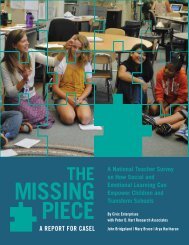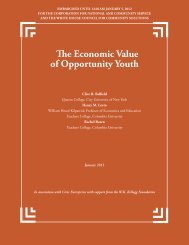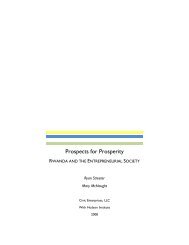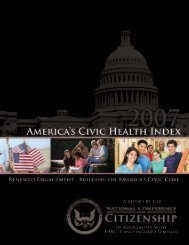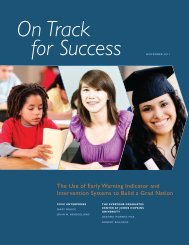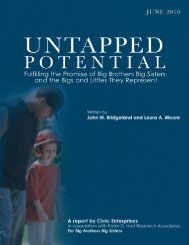A Call to Peace - Civic Enterprises
A Call to Peace - Civic Enterprises
A Call to Peace - Civic Enterprises
- No tags were found...
You also want an ePaper? Increase the reach of your titles
YUMPU automatically turns print PDFs into web optimized ePapers that Google loves.
Figure 15: Regions by Decade of Serviceunder half <strong>to</strong>day; but teachers still constitute thehighest percentage overall (figure 16). Making up thedifference, youth and community development, healthcare, information, and environmental conservation haveall grown as a share of volunteer activities since the<strong>Peace</strong> Corps’s inception.Figure 16: What did your <strong>Peace</strong> Corps Volunteerservice focus on?What Volunteers Do<strong>Peace</strong> Corps Volunteers serve for two years plusthree months of training for a <strong>to</strong>tal of 27 months. The<strong>Peace</strong> Corps does not offer shorter-term assignments,although once a <strong>Peace</strong> Corps Volunteer has served,he or she is eligible <strong>to</strong> participate in additionalshorter-term assignments as a part of the <strong>Peace</strong> CorpsResponse program. The work <strong>Peace</strong> Corps Volunteersdo is ultimately determined by the needs of hostcountries that invite them and also reflects theunderlying changes in the global economy overthe decades. The rise of environmentalism and theinformation age has dramatically affected the serviceof <strong>Peace</strong> Corps Volunteers.In his report <strong>to</strong> the President, Sargent Shriver indicatedthat the greatest need that the <strong>Peace</strong> Corps wouldfill was for trained teachers. Consistent with thatreport, the greatest demand from the field is still forteachers. Nearly two-thirds of <strong>Peace</strong> Corps Volunteerswere teachers in the first decade compared <strong>to</strong> justThe impact of the <strong>Peace</strong> Corps on its Volunteers isprofoundly personal. RPCVs report that their serviceinfluenced not only their political and policy views,but also such personal choices as their vocational andavocational pursuits (figure 17). More than half reporttheir service influenced their political views (53 percent)and three-quarters said it influenced their view of U.S.foreign policy (74 percent). Additionally, 26 percentsaid their service influenced their religious or spiritualbeliefs a great deal or a fair amount.“T E ACHING IN TANZANIA GAVE ME A LIFELONG INTEREST IN EDUCATION, ONE OF MY PRIMARY POINTSOF FOCUS AS GOVERNOR, AND IS CERTAINLY ONE OF THE REASONS WHY I AM ENJOYING MY WORKHERE AT THE UNIVERSITY OF DAYTON. IT’S REMARKABLE THE PEACE CORPS CONTINUES TO THRIVEIN ITS 50TH YEAR, PROVIDING LIFE-CHANGING VOLUNTEER OPPORTUNITIES FOR AMERICANS WHILEPRESENTING AN AUTHENTIC, DOWN TO EARTH VIEW OF OUR COUNTRY TO PEOPLE AROUND THEWORLD. LIVING AND WORKING IN ADEVELOPING COUNTRY HELPED ME APPRECIATE WHAT WE ENJOYIN THE U.S., ESPECIALLY OUR DEMOCRACY AND FUNDAMENTAL FREEDOMS. I ALSO GAINED ANAWARENESS OF THE NEEDS OF PEOPLE IN AFRICA AND OUR RESPONSIBILITY TO BE OF ASSISTANCEWHERE WE CAN.”—Bob Taft, former Republican Governor of OhioA CALL TO PEACE SEPTEMBER 201121|



